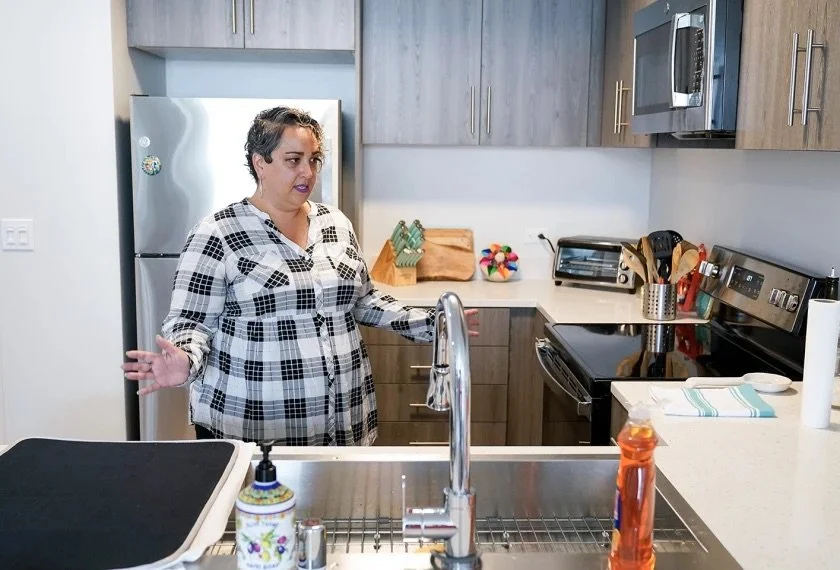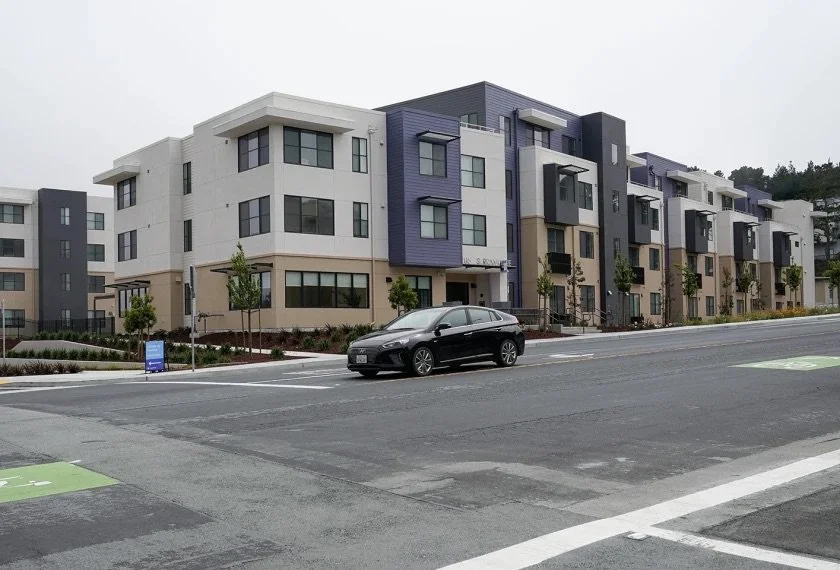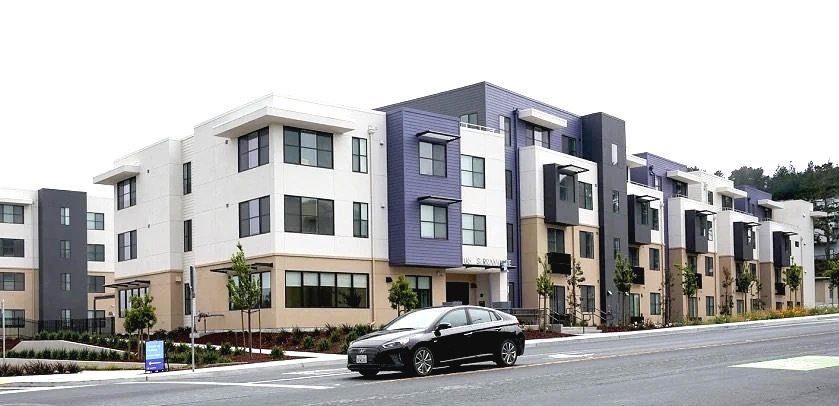‘Lesson Planning in the Laundry Room': What Housing for Teachers Looks Like
Education Week — Madeline Will
To respond to both soaring housing costs and staffing shortages, more school districts across the country are getting into the property management business. District leaders say that renting housing units to educators at below-market rates has become an effective recruitment and retention strategy…
Published in Education Week
Madeline Will December 4, 2023
To respond to both soaring housing costs and staffing shortages, more school districts across the country are getting into the property management business.
District leaders say that renting housing units to educators at below-market rates has become an effective recruitment and retention strategy. While overseeing housing complexes can be complicated, it can also be cost-effective: School districts can tap outside sources of funds to build the units, instead of dipping into their own coffers. Some districts even already own the land.
Six percent of district leaders and principals said they provide teacher housing or a housing supplement, according to a nationally representative EdWeek Research Center survey conducted this fall. Two percent said they’ve introduced or improved those benefits in the past two years, in response to staffing challenges.
The exact details vary from place to place. Education Week spoke to officials from four districts with workforce housing projects. Here’s how districts devised solutions in their communities.
In Miami, teachers could live and work in the same building
Florida’s Miami-Dade county and its school system are including workforce housing in a multi-million-dollar expansion of Southside Preparatory Academy, a pre-K-8 magnet school that needed additional seats for its middle school grades.
The seven-story building in the downtown Brickell neighborhood of the city will add capacity for 630 new students and include 10 housing units for educators in the district. The teachers who live in the building can—but do not have to—work at Southside.
Raul Perez, the chief facilities, design, and construction officer for the school district, said he saw some comments on social media from teachers who were concerned about the implications of living on the same site as a school. For example: “If I call out sick, they can come to my apartment to check on me.”
“The way that we envision it is not that at all,” Perez said.
The building is designed so that there is no overlap between the residential and the educational sides. If a teacher wanted to go from the school to their home, they’d have to leave the building and walk around the corner to a separate restricted-access entrance for residents only.
The district hopes to have the housing units available by the start of next school year. The county will determine the exact rental prices based on tenants’ income, but it’ll be significantly less than Miami’s typical market, Perez said.
“This is a way of having new teachers come on board and having an opportunity to start off with reasonable rental [prices]—and move on from there as their careers start to grow,” he said.
The district wants to replicate this project elsewhere, Perez said. Some schools are being underutilized due to recent enrollment declines, so renovating the school building and adding a residential component would be a “win-win,” he said.
In San Francisco, workforce housing has led to more teacher collaboration
The Jefferson Union high school district, located just south of San Francisco, opened an educator housing development a year and a half ago. District staff can live in one of the 122 units—which range in size from one to three bedrooms—for below market-rate rent.
The district has just started collecting data on the effects of the program, but Austin Worden, the district’s director of communication and staff housing, said early signs are promising. The district started this school year fully staffed with certified teachers.
It aims to keep the housing development approximately 60 percent certified staff and 40 percent classified staff, he said.
“A lot of teachers who live in the building, they love it,” Worden said. “They’re still able to maintain a sense of privacy ... [but] they’ve really embraced the sense of community living there.”
The building is designed with several community spaces, and Worden said the district staff and their families will often come together for karaoke nights or game-watching parties. Some of the teachers who live there will use the common areas for collaboration—he’s even noticed “lesson planning in the laundry room.”
The district is now exploring building another apartment complex on the same site that would generate money through market-rate rents.
A 100 percent goal for workforce housing in Aspen, Colorado
The Aspen school district is in a Colorado ski town, where property values are “through the roof,” said Superintendent Dave Baugh.
“Nobody can afford to buy a house,” Baugh said, adding that affordable housing is 60 to 70 miles away from the district’s schools. “As a superintendent, I can’t afford to live here.”
Baugh lives in district-owned housing—along with about 37 percent of the system’s 271 full-time employees. The district’s 15-year goal is to have the capacity for all its employees to live in workforce housing.
More Districts Are Building Housing for Teachers. Here’s What to Know.
Education Week, Madeline Will
School districts have a lot of responsibilities to manage. Some are adding housing to the list. More and more districts across the country are building housing complexes to rent to teachers and other school employees—often at below-market rates and on district-owned land. It’s a recruitment and retention strategy that has been fueled by both rising housing costs and staffing shortages…
Published in Education Week
By Madeline Will Nov 22, 2023
School districts have a lot of responsibilities to manage. Some are adding housing to the list.
More and more districts across the country are building housing complexes to rent to teachers and other school employees—often at below-market rates and on district-owned land. It’s a recruitment and retention strategy that has been fueled by both rising housing costs and staffing shortages.
“There’s momentum growing around this idea, and it’s definitely becoming normalized as a mainstream approach,” said Troy Flint, the chief communications officer for the California School Boards Association, which has been working with school districts in the state that are considering the idea. “That’s not to say most districts are doing this, but people understand the need and potential in a much more vivid way than they did even two years ago.”
Six percent of district leaders and principals said they provide teacher housing or a housing supplement, according to a nationally representative EdWeek Research Center survey conducted this fall. Two percent said they’ve introduced or improved those benefits in the past two years, in response to staffing challenges.
There is not yet much substantive research on how well these incentives work at recruiting and retaining teachers or on their broader place in affordable housing policy. But anecdotally, district leaders say that there’s high demand from their staff.
A separate EdWeek Research Center survey, conducted in July 2022, found that 11 percent of teachers said free or subsidized housing for educators would make them more likely to stay in the teaching profession long-term.
And an analysis earlier this year from the National Council on Teacher Quality found that in many major metropolitan areas, teachers are priced out of the housing market.
“We know that for teachers, housing is one of [their] primary financial concerns,” said Dana Cuff, the director of cityLAB, an architecture and urban research think tank at the University of California, Los Angeles. “Teachers need affordable housing.”
Workforce housing would also appeal to support staff, Flint said, adding that those classified employees are typically less well compensated than teachers and are more likely to live within the immediate community in which they work.
An effort taking root in California
California’s statewide approach to teacher housing is among the most robust.
The CSBA is working with cityLAB and the Center for Cities + Schools, a research center at the University of California, Berkeley, to offer resources and technical assistance to interested school districts. (The Chan Zuckerberg Initiative is supporting their work. CZI also supports Education Week, but the media organization retains full editorial control over its articles.)
The groups released a report last February that found that every county in California has land of one acre or more that’s owned by a local education agency and is potentially developable, meaning it is underused or completely unutilized. Of the more than 7,000 properties with potentially developable land, 61 percent are located where beginning teachers struggle to afford housing.
“It’s really beautifully distributed throughout the state,” Cuff said. “In rural districts, there’s not very much housing available within a reasonable distance. Urban districts are having deep problems with affordability.”
Right now, at least three school districts in the state—Los Angeles, Santa Clara, and Jefferson Union, a high school district—have educator workforce housing developments. Many more are interested.
At least 80 school districts in the state have expressed interest in learning more about the process, although only about a dozen districts have enrolled in a series of workshops offered by the organizations so far. The workshops help districts explore the logistics of the process and put together a school board resolution to endorse the idea. A second phase of the training will walk districts that are further along through the process of preparing a request for proposal, Cuff said.
The factors districts have to consider
There’s a lot of work districts need to do before they can even consider breaking ground on educator workforce housing, Flint said.
He recommends that districts start the process by surveying their staff and doing some research: How many employees would be interested in workforce housing? Does workforce housing make sense, given the dynamics of the real estate market where educators currently live?
Districts should also look at demographic trends in the short- and long-term, Flint said. And they should consider their available land and how a housing development would fit into the surrounding neighborhood from a logistical and aesthetic perspective. How welcoming would the neighborhood be to this development?
Districts must also think through all the logistics of how educator workforce housing will work.
Jeff Vincent, the director of public infrastructure initiatives at the Center for Cities + Schools, said it’s typically more cost-effective for districts to build multi-family housing, such as an apartment complex or townhouses, than single-family homes. But the staffing survey will help bring clarity about the type of housing that’s needed, as well as the number and size of units.
How a Parking Lot Became a Panacea for This School District’s Housing Crisis
EdSurge, Emily Tate Sullivan
Shirley Cruz used to pass an old parking lot on her way to and from work…Now, Cruz doesn’t drive past it. She lives on it — in a district-owned, newly constructed apartment complex occupied exclusively by the teachers and staff of Jefferson Union High School District…
Published in EdSurge
By Emily Tate Sullivan September 18, 2023
Shirley Cruz used to pass an old parking lot on her way to and from work.
Adjacent to a former high school, the lot was wasted space back then, she says. Uber and Lyft drivers would congregate there, waiting to get assigned to their next rides, Cruz recalls. Otherwise, it sat empty.
In Daly City, California, just south of San Francisco city limits, that’s prime real estate. The owners of the abandoned parking lot and the land beneath it — the local school district — realized as much, and they hatched a plan.
Now, Cruz doesn’t drive past it. She lives on it — in a district-owned, newly constructed apartment complex occupied exclusively by the teachers and staff of Jefferson Union High School District.
It’s an approach that is gaining momentum among public school districts nationwide. Many are dealing with vacancies and educator attrition rates at levels that are not only inconvenient but actually harmful to the staff, students and families in their communities. In a number of places, including the San Francisco Bay Area, exorbitant housing costs are responsible for high teacher turnover rates. So districts, often sitting on vast swaths of underused and undeveloped land, are getting creative.
Jefferson Union High School District is among the first school districts in the country to see its affordable housing project through to completion — staff began moving in over a year ago, and today, the 122-unit complex is fully occupied — but scores of others are not far behind.
In California alone, at least 46 school districts were pursuing workforce housing projects on 83 sites statewide as of March 2022, according to research from the Center for Cities + Schools at the University of California, Berkeley. Projects in North Carolina, Texas, Missouri, Colorado, Illinois and elsewhere are also underway.
As more districts seek to address the housing crisis in their communities — an issue EdSurge explored in depth in a recent story — we wanted to look at the school district in Daly City that, at least for now, has solved its housing woes.
Drawing Up Plans
Before its employee housing program launched in 2022, JUHSD was losing between 20 and 25 percent of its staff every year.
“We kept hearing, ‘It’s not because we don’t want to work here. It’s because we can’t live here,’” says Austin Worden, director of communication and staff housing for the district.
Housing in the Bay Area is notoriously pricey, notes Worden, “but in recent years, the spike is just unreal — just through the roof,” he says. The average rent for apartments in Daly City in 2023 ranges between $2,344 and $3,692 a month, according to Rent.com. “What we’re giving in salary raises doesn’t even compete,” Worden adds.
JUHSD is the lowest-funded high school district in San Mateo County, California, which is one of the most expensive places to live in the United States. Teacher salaries in Jefferson Union range from around $62,000 to $107,000 a year, compared to nearby San Mateo Union High School District, where teachers can earn between $79,000 and $148,000 a year.
School districts sometimes raise money by selling bonds, but Jefferson Union leaders knew they wouldn’t be able to use bond funds to increase staff salaries. What they could do with a bond was build. The district had plenty of land and property ripe for development. If housing was the main driver of high turnover rates and district leaders couldn’t adjust salaries in line with housing costs, they thought, why not just build staff housing?
A $33 million voter-approved bond passed in June 2018. The remainder of the $75.5 million housing project was financed through a Certificate of Participation (COP).
The goal, says Worden, was for about a quarter of the district’s 530 staff members to live in the eventual apartment complex, and to price rent for the units about 50 percent below market rates.
In practice, the rental units are around 60 percent of market rates — between $1,350 and $1,580 a month for a one-bedroom apartment in the district-owned building, compared to about $2,400 a month elsewhere, Worden says — so a considerable discount.
By May 2022, staff were moving into the building, which has a mix of one-, two- and three-bedroom units and includes modern appliances and amenities such as a fitness center, common rooms with workspaces, playgrounds, community centers and parking.
“It’s stunning,” Worden says of the building. “The goal was to create a product that was on par with at-market rate [alternatives]. It rivals buildings I’ve seen in San Francisco.”
He remembers giving tours to interested staff and reveling in their “oohs” and “ahhs” as they walked into individual units. Many hadn’t known what to expect of the district’s development, but once in the building, he says, they were impressed.
Colleagues as Neighbors
Cruz was one of the employees who found herself pleasantly surprised by the finished product.
The 67-year-old remembers hearing about the plan to develop educator workforce housing a few years ago and says she started angling for a unit in the new complex “the minute they started building.”
“Housing is extremely difficult here,” says Cruz, who was born and raised in San Francisco. “None of us is getting paid what we’re worth.”
She and her husband had been paying more in rent than they felt comfortable with to live in an apartment building in Daly City that she describes as rundown. On their modest salaries — she is an administrative assistant to a high school principal at JUHSD, and her husband drives a mail truck for the San Francisco Unified School District — they were maxed out.
“We were paying more and more each year for less and less,” Cruz says, explaining that their rent would always go up even as the conditions of the building deteriorated.
So when Cruz learned she and her husband would get to move into a two-bedroom unit in the complex last spring — and pay $1,000 less per month than their previous rent — she was thrilled.
“This was a godsend,” she says.
The building is beautiful, and the amenities match those of luxury buildings, Cruz says. But most importantly, it’s affordable.
“This housing project has really afforded people like myself to continue living and working in this area, and it’s also afforded teachers who have never had a place of their own to have a place and not have to work two and three jobs to support themselves,” she explains. “It’s been a pretty remarkable situation.”
For a relatively small school district with about 25 percent of its entire staff housed in one building, residents are bound to see familiar faces in the elevators and along the hallways. Cruz lives in between a colleague she knew from her old job in the district and a counselor at the high school where she currently works.
She regularly runs into her counselor-neighbor at the fitness center, she says. She sees other colleagues in the shared laundry room.
“I had to get used to, ‘OK, you guys are going to see me in my sloppy clothes,’” Cruz shares. But she actually relishes living in a community with her district coworkers.
“There’s a certain amount of pride in taking care of the place we’re all living and supporting each other,” Cruz says. “I like parking next to people where I know I don’t want to hit their car and they don’t want to hit mine. It’s familiar without being intrusive.”
Problem Solved?
One year into living in district housing, Cruz has noticed that turnover seems to have slowed, at least at her school.
“This year was the first time we haven’t had to replace 10 teachers at the end of the school year,” she says.
District leaders say it’s too soon to make sweeping assessments about the turnover. They don’t expect to have “solid data” until December, says Tina Van Raaphorst, JUHSD’s deputy superintendent of business services. But what she does have is anecdotal evidence, and that looks promising.
JUHSD started the 2022-23 school year — the first full year since opening the apartment building — with all teaching positions filled, “at a time when some other districts in our area and statewide were not able to find enough teachers,” Van Raaphorst shared in an email. She’s heard from at least two teachers who say they stayed in the district because of the employee housing and from others who say they have been able to take on coaching opportunities and other extracurriculars for the district because their commute is shorter or they don’t have to work a second job in the evenings.
Worden, the director of staff housing, shares that the housing benefit has helped with recruitment, too. The district hired a teacher who came up from Los Angeles after hearing about the staff housing. Another teacher from North Carolina who’d always wanted to teach and live in the Bay Area decided to make the cross-country move after learning she could live in the district’s subsidized housing.
“We’re already seeing the positive benefits of it,” Worden says.
So, is that it? Is the problem solved at JUHSD?
In the short term, yes, Worden says.
The one hang-up is that, at present, residents have been told they can live in the district-owned apartment for five years. The idea is to “encourage residents to financially save for their future home,” Worden says, “along with this giving space to future employees wanting the opportunity to live in the educational housing building.”
Cruz is skeptical that anyone in the district — a teacher, or a school support staff member like her — will be able to save enough money in five years to buy a home in the area. The rent is a major improvement over what many residents were paying, but in many places, those prices would still be eye-popping.
That five-year limit is not locked in, though, Worden notes. It has the potential to be extended, depending on demand for the district housing. (There is currently a waitlist for the units.)
So far, the project has been such a success that Worden hopes to see more school districts using their land assets for educator housing. Based on how many have inquired about the project and asked to tour the complex, it seems likely he soon will.
He often tells other district leaders to get creative. Do they have an old athletic field they could build on? Or maybe, as in the case of JUHSD, an empty parking lot?
As for Cruz, she is staying put for as long as she’s allowed.
“The rent is so affordable that I’m afraid to stop working,” she says. “I really don’t think I’m going to have the opportunity to retire anytime soon, so I feel like I’m winging it right now. I’ll just keep working as long as I can, and we’ll keep living here.”
And once her time is up? Well, luckily, her husband’s school district has broken ground on its own affordable housing project for educators. Maybe next, the couple will call that community home.





